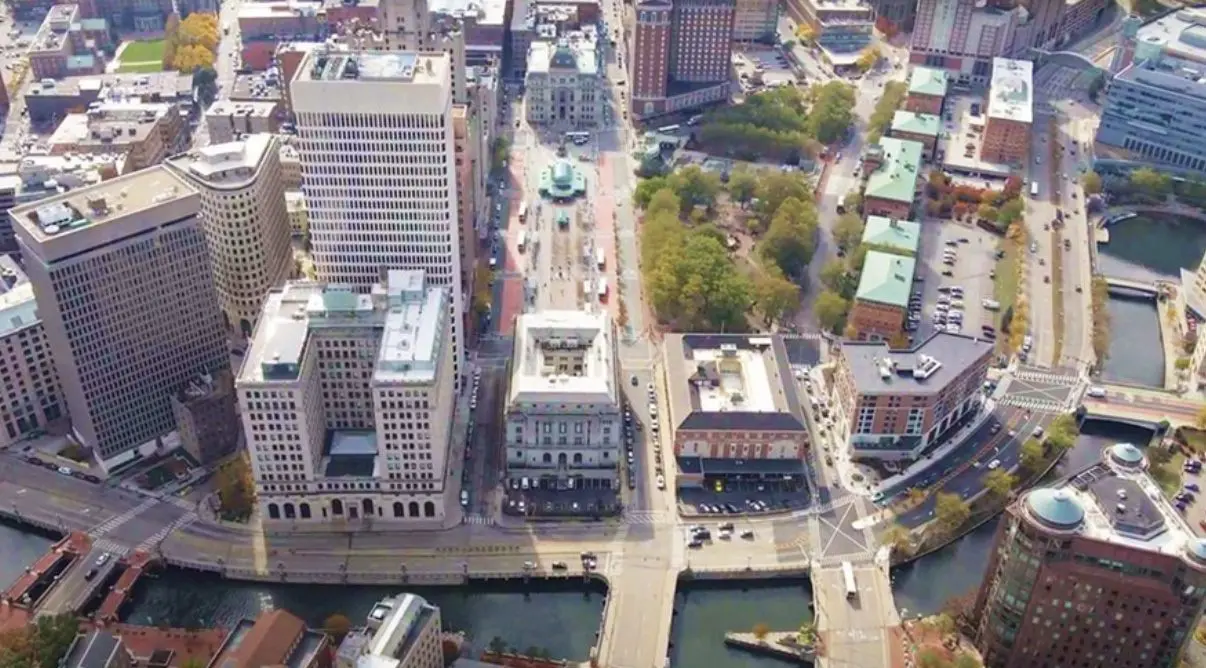Search Posts
Recent Posts
- Rhode Island Weather for June 1, 2025 – Jack Donnelly June 1, 2025
- To Do in RI: 26th Annual Rose Show of the Rhode Island Rose Society June 1, 2025
- Victory is ours: Victory gardens are blossoming again – Chuck Norris June 1, 2025
- Ask Chef Walter: The problem with “The Best” – Chef Walter Potenza June 1, 2025
- Gimme’ Shelter: Kava is waiting at the Providence Animal Control Center June 1, 2025
Categories
Subscribe!
Thanks for subscribing! Please check your email for further instructions.

Kennedy Plaza is still at risk
by David Brussat, Architecture Here and There, contributing writer, architecture
Efforts by the city and state governments to make Kennedy Plaza ugly have not yet succeeded in making it fail. But the attempt to ruin the central public square of Providence is ongoing. The plaza’s beauty has diminished greatly since its Art Nouveau waiting kiosks were replaced by sterile modernist ones, but the plaza remains an effective main hub for public transit.
Not for long, though, if city and state transportation officials have their way.
They have already added new waiting kiosks in the Jewelry District that look like equipment from a torture chamber (or, less harshly, an ironing board). Now, in addition to ramming through a new multi-hub plan opposed by the bus-riding public, they are planning to “re-envision” aspects of Waterplace Park, the river walks, the pedestrian tunnels under Memorial Boulevard and Exchange Terrace, and other downtown amenities.
According to a news report by SmartCitiesWorld, the engineering firm Arup, hired to design this “single cohesive vision,” said its “placemaking modifications” include: a cohesive artistic lighting plan; shade structures and two temporary liner buildings at the Providence Rink; a utility plan for Waterplace Park, the tunnels, and Riverwalk between Francis and Steeple streets; a programming plan for the central plaza area at Kennedy Plaza; and a series of modifications to make Waterplace Park and the Riverwalk more accessible and pedestrian friendly. Overall climate resilience in Waterplace Park and along the Riverwalk will also be addressed.
Much of that sounds benign. No doubt these areas can be improved. The river-relocation project of 1990-1996, which daylighted the downtown rivers and created Waterplace, the river walks and a dozen elegant bridges, is almost a quarter of a century old, and is showing its age. For example, there is much spawling on too many of the bridges. Fine. Yet maybe that’s not what this is all about. Curious motives seem to emerge in boilerplate language from Arup: There has never been a more important time for us to set a new benchmark for inclusivity, equity, respect and ownership of these shared spaces, ensuring that accessibility means access for all, not just for some.
They probably say that to all the cities!
And yet, at a time of exceptionally constrained city and state budgets, what does it really mean?
What is this “new benchmark”? Where in the public spaces now targeted for “improvement” have such values as inclusivity, equity, respect, ownership and accessibility been slighted? Are these parks, bridges and river walks not open to all? Is there some sort of stroll tax levied to enter the grounds?
It is obvious that there are no such constraints on the use or enjoyment of these relatively new urban features, paid for almost exclusively by taxpayers outside of Providence and Rhode Island. If there are constraints in the offing, they are the burdensome bus transfers and walking distances to be required of users by the proposed multi-hub system, especially the most needy users. (My post “Still attacking Kennedy Plaza,” from August, focuses on the multiple hubs.)
More than anything else, the “single cohesive vision” sounds like a perfect opportunity to waste taxpayer money on things that aren’t needed.
Because of the masterful work decades ago by the late Bill Warner, who led the effort to redesign the waterfront, the city of Providence and the state of Rhode Island transformed rivers covered up little by little over a century into an urban paradise. This work successfully revived the city’s fortunes. Warner recognized that historic beauty was the capital city’s saving grace, and designed the new waterfront to reflect the legacy of its past. Warner’s accomplishments belong to all citizens, and they must be protected from those whose vision of the future cannot abide its glorious past.
_____

My freelance writing and editing on architecture and others addresses issues of design and culture locally and globally. I am a member of the board of the New England chapter of the Institute of Classical Architecture & Art, which bestowed an Arthur Ross Award on me in 2002. I work from Providence, R.I., where I live with my wife Victoria, my son Billy and our cat Gato. If you would like to employ my writing and editing to improve your work, please email me at my consultancy, dbrussat@gmail.com, or call (401) 351-0457 https://architecturehereandthere.com/

